Population–Land–Industry–Facility System Coupling Coordination and Influencing Factors in Hebei Province
Abstract
1. Introduction
2. Materials and Methods
2.1. Research Framework
2.2. Population, Land, Industry, and Facilities Interactions
2.3. Study Area
2.4. Data Sources
2.5. Research Methods
2.5.1. Construction of the PLIF Evaluation Index System
2.5.2. Integrated Evaluation Index
2.5.3. Coupling Coordination Degree Model
2.5.4. Spatial Autocorrelation
2.5.5. Grey Correlation Degree Analysis
3. Results
3.1. Analysis of Development Characteristics of the PLIF System
3.1.1. Spatial–Temporal Evolution Characteristics of Development Levels Across Subsystems
3.1.2. Analysis of the Comprehensive Development Level of the PLIF System
3.2. Coupled Coordination Analysis of the PLIF System
3.2.1. Spatiotemporal Evolution Characteristics of Coupling Coordination
3.2.2. Spatiotemporal Evolution Characteristics of Coupling Coordination Degree
3.2.3. Spatial Agglomeration Features of the Coupling Coordination Degree
3.3. Analysis of Grey Relational Results for Factors Influencing the Degree of Coupling Coordination of the PLIF System
4. Discussion
4.1. Research Findings and Rationality Analysis
4.2. Suggestions for Improving Coupling Coordination and Development of Regional PLIF Systems
5. Conclusions
- (1)
- The overall development level of the PLIF system is relatively low, with significant spatial variation. Although the development levels of each subsystem and the comprehensive development level show an upward trend, they remain at a low stage. Spatially, it exhibits an “east-high, west-low” and “core-periphery” structure. The eastern and central regions, leveraging their locational advantages and economic foundation, have relatively higher development levels. In contrast, areas such as Zhangjiakou, Chengde, and western Baoding, constrained by natural conditions and industrial structure, lag behind in development, reflecting the prominent regional development imbalance in Hebei Province.
- (2)
- The coupling coordination degree of the PLIF system shows a fluctuating upward trend, but the quality of coordination still needs improvement. Although most counties are in the high-level coupling stage, the coordination degree generally displays a “low in the north, high in the south; low in the west, high in the east” pattern. Highly coordinated areas are concentrated in coastal regions like Tangshan and Qinhuangdao, while mildly disordered areas are consistently distributed in the ecologically sensitive northwestern region. The slight decline in coordination degree in the later stage indicates that the system’s coordinated state is not yet stable and is susceptible to policy adjustments and changes in the external environment, demonstrating a certain degree of vulnerability.
- (3)
- The coupling coordination degree of the PLIF system shows significant spatial aggregation characteristics. High-High (H-H) aggregation areas are mainly distributed in the coastal areas of northeastern Hebei, while Low-Low (L-L) aggregation areas are concentrated in the northwestern mountainous region, reflecting the “low-level lock-in” spatial dilemma faced by disadvantaged areas. The number of High-Low (H-L) and Low-High (L-H) type areas is small and their distribution is unstable. For instance, high-low types only sporadically appear in Zhangjiakou City, and Low-High (L-H) types only occur in certain years in individual counties like Qinglong and Lulong. This indicates that the radiating influence between regions is relatively weak, lacking effective transition and transmission mechanisms.
- (4)
- Population and land factors are key influences on the coupling coordination degree of the PLIF system. Results from the grey relational analysis show that the population subsystem has the highest relational degree, followed by the land subsystem, while the industry and facility subsystems have relatively weaker influences. At the specific indicator level, population density, the proportion of the tertiary industry, the degree of non-agriculturalization of the rural labor force, the number of full-time teachers in regular secondary schools per 10,000 people, and public fiscal revenue per unit of land area are closely related to the coordination degree. This indicates that population structure and land use play a dominant role in system coordination, while the supportive effect of facility construction has not yet been fully realized.
Author Contributions
Funding
Data Availability Statement
Acknowledgments
Conflicts of Interest
References
- Herrmann, S.M.; Brandt, M.; Rasmussen, K.; Fensholt, R. Accelerating land cover change in West Africa over four decades as population pressure increased. Commun. Earth Environ. 2020, 1, 53. [Google Scholar] [CrossRef]
- Gryshova, I.; Kyzym, M.; Khaustova, V.; Korneev, V.; Kramarev, H. Assessment of the industrial structure and its influence on sustainable economic development and quality of life of the population of different world countries. Sustainability 2020, 12, 2072. [Google Scholar] [CrossRef]
- Pandey, B.; Brelsford, C.; Seto, K.C. Rising infrastructure inequalities accompany urbanization and economic development. Nat. Commun. 2025, 16, 1193. [Google Scholar] [CrossRef] [PubMed]
- Almulhim, A.I.; Cobbinah, P.B. Urbanization-environment conundrum: An invitation to sustainable development in Saudi Arabian cities. Int. J. Sustain. Dev. World Ecol. 2023, 30, 359–373. [Google Scholar] [CrossRef]
- Atefeh, M.; Parvaneh, S.; Romina, S. Assessment of the ecological footprint associated with consumption resources and urbanization development in Sistan and Baluchestan province, Iran. Results Eng. 2022, 16, 100673. [Google Scholar] [CrossRef]
- Khan, S.U.; Cui, Y. Identifying the impact factors of sustainable development efficiency: Integrating environmental degradation, population density, industrial structure, GDP per capita, urbanization, and technology. Environ. Sci. Pollut. Res. 2022, 29, 56098–56113. [Google Scholar] [CrossRef] [PubMed]
- Tian, Y.Y.; Jiang, G.H.; Ma, W.Q.; Wu, S.D.; Tian, Y.Y.; Zhou, T. Understanding the relationship between population–land–industry element inputs and function outputs of rural settlement: An efficiency-based perspective. Habitat Int. 2025, 159, 103370. [Google Scholar] [CrossRef]
- Marhasova, V.; Tulchynska, S.; Popelo, O.; Garafonova, O.; Yaroshenko, I.; Semykhulyna, I. Modeling the harmony of economic development of regions in the context of sustainable development. Int. J. Sustain. Dev. Plann. 2022, 17, 441–448. [Google Scholar] [CrossRef]
- Liu, Z.Y.; Wang, X.Z.; Qian, H.; Xue, H.Y.; Li, H. Territorial spatial characteristics, issues, and planning responses of agricultural plains from the rerspective of population-land-industry coordination: The case of Huang-Huai-Hai plain. Urban. Plan. Forum. 2024, 32–41. [Google Scholar] [CrossRef]
- Cheng, M.Y.; Liu, Y.S.; Jiang, N. Study on the spatial pattern and mechanism of rural population-land-industry coordinating development in Huang-Huai-Hai Area. Acta Geogr. Sin. 2019, 74, 1576–1589. [Google Scholar] [CrossRef]
- Ma, L.B.; Chen, M.M.; Che, X.L.; Fang, F. Research on population-land-industry relationship pattern in underdeveloped regions: Gansu province of western China as an example. Sustainability 2019, 11, 2434. [Google Scholar] [CrossRef]
- Zhou, F.L.; Liao, H.P.; Zhang, Q.Q. Coupling and coordination of rural “People, land and Industry” transformation from the perspective of economic gradient—A case study of two towns in Yubei district of Chongqing. J. Southwest Univ. Nat. Sci. Ed. 2021, 43, 129–141. [Google Scholar] [CrossRef]
- Sarayrah, H.; Hayek, W.; Thneibat, A.; Ibrahim, M. Mapping of population growth influence on land use transformation from 1994 to 2015 in Madaba Governorate, Jordan. Environ. Monit. Assess. 2024, 196, 250. [Google Scholar] [CrossRef]
- Tendaupenyu, P.; Dennis, M.C.H.; Murwira, A. Changes in landuse/landcover patterns and human population growth in the Lake Chivero catchment, Zimbabwe. Geocarto Int. 2017, 32, 797–811. [Google Scholar] [CrossRef]
- Bawazir, A.A.A.; Aslam, M.; Osman, A.F.B. Demographic change and economic growth: Empirical evidence from the Middle East. Econ. Change Restruct. 2020, 53, 429–450. [Google Scholar] [CrossRef]
- Gleria, I.; DaSilva, S.; Brenig, L.; Rocha, T.M.; Figueiredo, A. Modified Verhulst-Solow model for long-term population and economic growth. J. Stat. Mech-Theory E 2024, 2024, 023406. [Google Scholar] [CrossRef]
- Huang, C.K.; Lin, F.Y.; Chu, D.P.; Wang, L.L.; Liao, J.W.; Wu, J.Q. Coupling relationship and interactive response between intensive land Use and tourism industry development in China’s major tourist cities. Land 2021, 10, 697. [Google Scholar] [CrossRef]
- Qian, Y.F. Research on the coupling relationship between industrial structure and land use structure under urban transformation and the optimization scheme of land use structure. J. Southwest Univ. Nat. Sci. Ed. 2024, 46, 86–94. [Google Scholar] [CrossRef]
- Liu, C.; Zeng, Y.; Cai, X.Q.; Zhao, K.W. Rural population-land-industry in Dongting lake eco-economic zone: Spatial-temporal differentiation of the coupling coordination degree. J. Agric. 2022, 12, 77–84. [Google Scholar] [CrossRef]
- Chen, X.L.; Zhu, S.Y.; Kong, X.S.; Chen, C.F. Dynamic and static characteristics of spatio-temporal population, land, and industry in Hubei province. Chin. J. Agric. Resour. Reg. Plan. 2021, 42, 31–38. [Google Scholar]
- Cui, S.Q.; Zhou, G.H.; Li, X.Q.; Wu, G.H. Simulation of urban-rural integration development of Changsha-Zhuzhou-Xiangtan urban agglomeration from the perspective of “human-land-industry” coordination. Prog. Geogr. 2024, 43, 1337–1354. [Google Scholar] [CrossRef]
- Huang, J.; Xue, D.Q.; Ma, B.B.; Song, Y.Y. Spatio and temporal evolution pattern and driving mechanism of coordinated level of human-land-industry system in rural areas of the Loess Plateau. Hum. Geogr. 2021, 36, 117–128. [Google Scholar] [CrossRef]
- Huang, L.J.; Yang, P.; Zhang, B.Q.; Hu, W.Y. Spatio-temporal coupling characteristics and the driving mechanism of population-land-industry urbanization in the Yangtze river economic belt. Land 2021, 10, 400. [Google Scholar] [CrossRef]
- Liu, Y.J.; Zhou, G.L.; Liu, D.G.; Yu, H.S.; Zhu, L.Y.; Zhang, J. The Interaction of population, industry and land in process of urbanization in China: A case study in Jilin province. Chin. Geogr. Sci. 2018, 28, 529–542. [Google Scholar] [CrossRef]
- Li, T.; Liao, H.P.; Wang, W.; Zhuang, W.; Shi, J. Urbanization quality over time and space as well as coupling coordination of land, population and industrialization in Chongqing. Econ. Geogr. 2015, 35, 65–71. [Google Scholar] [CrossRef]
- Zhang, Y.J.; Su, Z.G.; Li, G.; Zhuo, Y.F.; Xu, Z.G. Spatial-temporal evolution of sustainable urbanization development: A perspective of the coupling coordination development based on population, industry, and built-up land spatial agglomeration. Sustainability 2018, 10, 1766. [Google Scholar] [CrossRef]
- Zhan, Y.J.; Ji, Y.X.; Huang, J.J.; Ma, C.Y.; Ma, C.Q. Land-population-industry based village evolution and its influencing factors in the upper Tuojiang River. J. Mt. Sci. 2024, 21, 2790–2809. [Google Scholar] [CrossRef]
- Xu, J.; Liu, H. Spatiotemporal evolution and driving factors of the coupling coordination of the population-land-water-industry system in the lower Yellow River. Sci. Rep. 2024, 14, 23067. [Google Scholar] [CrossRef]
- Ji, Z.J.; Zhang, J.Y.; Wang, J.P.; Du, X.B. Study on the pattern and mechanism of the coupling and coordinated development of rural population-land-industry-finance system: Taking typical counties in the three Gorges reservoir area of Chongqing as an example. J. Chongqing Norm. Univ. Nat. Sci. 2023, 40, 48–60. [Google Scholar]
- Lyu, X.; Wang, Y.N.; Zhao, Y.T.; Niu, S.D. Spatio-temporal pattern and mechanism of coordinated development of “population–land–industry–money” in rural areas of three provinces in Northeast China. Growth Change 2022, 53, 1333–1361. [Google Scholar] [CrossRef]
- Bernard, A.C. Analysis of the two-way causal nexus between macroeconomic factors and infrastructure development: The experience of selected African countries. J. Econ. Adm. Sci. 2023, 39, 322–339. [Google Scholar] [CrossRef]
- Heshmati, A.; Rashidghalam, M. Measurement and analysis of urban infrastructure and its effects on urbanization in China. J. Infrastruct. Syst. 2020, 26, 04019030. [Google Scholar] [CrossRef]
- Abdelhalim, B. GIS-based multi-criteria decision analysis for the optimal location of public facility in Batna city, Algeria. J. Indian Soc. Remote Sens. 2024, 52, 1073–1084. [Google Scholar] [CrossRef]
- Wang, S.; Cheng, H.F. Research on the coupling between public service facilities and residential space based on POI date—A case of Guandu district in Kunming. Urban Archit. 2021, 18, 102–106. [Google Scholar] [CrossRef]
- Huang, J.R.; Song, C.; Zhang, K. Assessment of the coordination between urban spatial structure and transportation system or-ganization: A case study of Guangzhou. Urban Transp. China 2024, 22, 77–84. [Google Scholar]
- Tokunova, G. Assessment of the transport infrastructure influence on urban agglomerations development. Transp. Res. Procedia 2018, 36, 745–758. [Google Scholar] [CrossRef]
- Cui, Y.; Wang, S. Evaluation on the coupling and coordinated development between information infrastructure and upgrading of industrial structure in Beijing-Tianjin-Hebei. J. Tianjin Univ. Commer. 2021, 41, 12–19. [Google Scholar] [CrossRef]
- Lu, A.M.; Zhang, S.P. Impact of new infrastructure on the coupling and coordination of the digital economy and the high-quality development of the manufacturing industry. Mod. Ind. Econ. Inf. 2024, 14, 9–12. [Google Scholar] [CrossRef]
- Ren, Q.R.; Yu, E.Y. Coupling analysis on coordinated development of ecological environment and social economic system in Gansu province. Acta Ecol. Sin. 2021, 41, 2944–2953. [Google Scholar] [CrossRef]
- Ye, Y.A.; Li, Y.Y.; Yang, Q.Q.; Jiao, L.J.; Xu, T.; Sun, Z.H. Research on the coupling and coordination of ecological environment infrastructure, environmental quality, and social economy in Jiangsu province. Environ. Ecol. 2025, 7, 35–41. [Google Scholar]
- Pan, Q.C. Research on the Coupling of “Human-Land-Industry” Factors at Different Scales in Rural Regional Systems. Master’s Thesis, Zhejiang Gongshang University, Hangzhou, China, January 2023. [Google Scholar]
- Zhang, H.Z.; Yang, Q.Y. Characteristics of “population-land-industry” coordinated development of resource-based shrinking cities in China. World Reg. Stud. 2024, 33, 163–177. [Google Scholar] [CrossRef]
- Yang, J.; Huang, X. The 30 m annual land cover dataset and its dynamics in China from 1990 to 2019. Earth Syst. Sci. Data 2021, 13, 3907–3925. [Google Scholar] [CrossRef]
- Chen, Y.E.; Sun, Q. A study on calculation of development of China’s infrastructure and its influencing factors—The empirical research based on provincial Panel data. Econ. Geogr. 2016, 36, 23–30. [Google Scholar] [CrossRef]
- Fang, F. Evaluation and spatial distinction of the coupling of population-land-industry elements in the counties of Beijing-Tianjin-Hebei Region. World Reg. Stud. 2018, 27, 51–59. [Google Scholar] [CrossRef]
- Liu, Q. Optimization Study on the Coupled and Coordinated Development of “People-Land-Industry” in the Border Counties of Inner Mongolia. Master’s Thesis, Inner Mongolia Normal University, Hohhot, China, June 2024. [Google Scholar]
- Song, S.Y.; Jiang, D.M.; Li, X.S.; Hang, J.T. Study on the coupled and coordinated development of “population-land-industry” in coal resource-exhausted cities. China Min. Mag. 2021, 30, 57–65. [Google Scholar] [CrossRef]
- Cong, X.N. Expression and mathematical property of coupling model and its misuse in geographical science. Econ. Geogr. 2019, 39, 18–25. [Google Scholar] [CrossRef]
- Zhu, J.L.; Li, Z.L. Coupling coordination development of industry-population-space in city cluster of Yangtze River delta region. China Popul. Resour. Environ. 2015, 25, 75–82. [Google Scholar] [CrossRef]
- Wang, C.; Tang, N. Spatio-temporal characteristics and evolution of rural production-living-ecological space function coupling coordination in Chongqing Municipality. Geogr. Res. 2018, 37, 1100–1114. [Google Scholar]
- Wang, Y.; Shen, Y. Spatial autocorrelation methods and their main applications. Chin. J. Health Stat. 2008, 443–445. [Google Scholar]
- Zhou, W.H.; Zeng, B. A research review of grey relational degree model. Stat. Decis. 2020, 36, 29–34. [Google Scholar] [CrossRef]
- Li, X.H.; Liu, Y.S.; Guo, Y.Z. The spatial pattern of population-land-industry coupling coordinated development and its influencing factor detection in rural China. J. Geogr. Sci. 2023, 33, 2257–2277. [Google Scholar] [CrossRef]
- Xu, L.; Zhang, P.P.; Zhang, G.J.; Yang, J.Y.; Hu, F.; Ma, L.J. Resilience and coordination characteristics of rural territorial system of counties in Hebei province based on structure and function. Geogr. Geo-Inf. Sci. 2023, 39, 98–106+130. [Google Scholar] [CrossRef]
- Zhang, Y.; Wu, K.N.; Li, X.L.; Kang, L.; Meng, J.L. Study on spatial-temporal differentiation and coupling coordination degree of multi-functionality of county land use in Hebei province. Chin. J. Agric. Resour. Reg. Plan. 2024, 45, 150–161. [Google Scholar]
- Shi, W.H.; Tian, J.; Namaiti, A.; Xing, X.X. Spatial-temporal evolution and driving factors of the coupling coordination between urbanization and urban resilience: A case study of the 167 Counties in Hebei province. Int. J. Environ. Res. Public Health 2022, 19, 13128. [Google Scholar] [CrossRef]
- Liu, Z.H.; Guan, X.J.; Wu, W.H.; Yang, Y.Y.; Shi, R.G. Research on the pattern and driving mechanism of coordinated development of rural people-land-industry in Ningxia, China. J. Agric. Resour. Environ. 2024, 42, 1105. [Google Scholar] [CrossRef]
- Huang, L.J.; Yang, P. Spatio-Temporal coordination characteristics and driving factors of population-land-industry non-agriculturalization the Yangtze river economic belt. Chin. J. Agric. Resour. Reg. Plan. 2021, 42, 182–192. [Google Scholar]

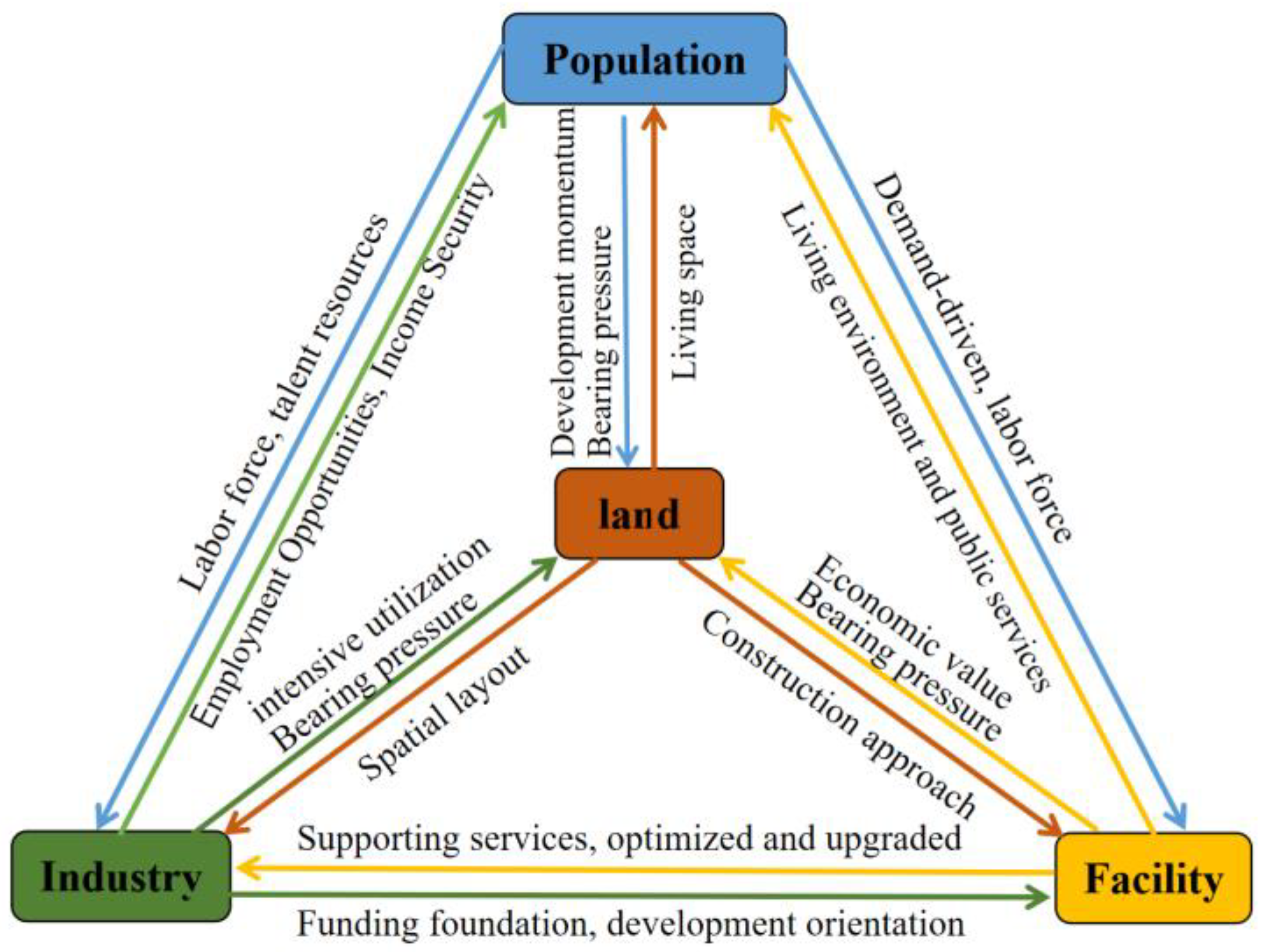

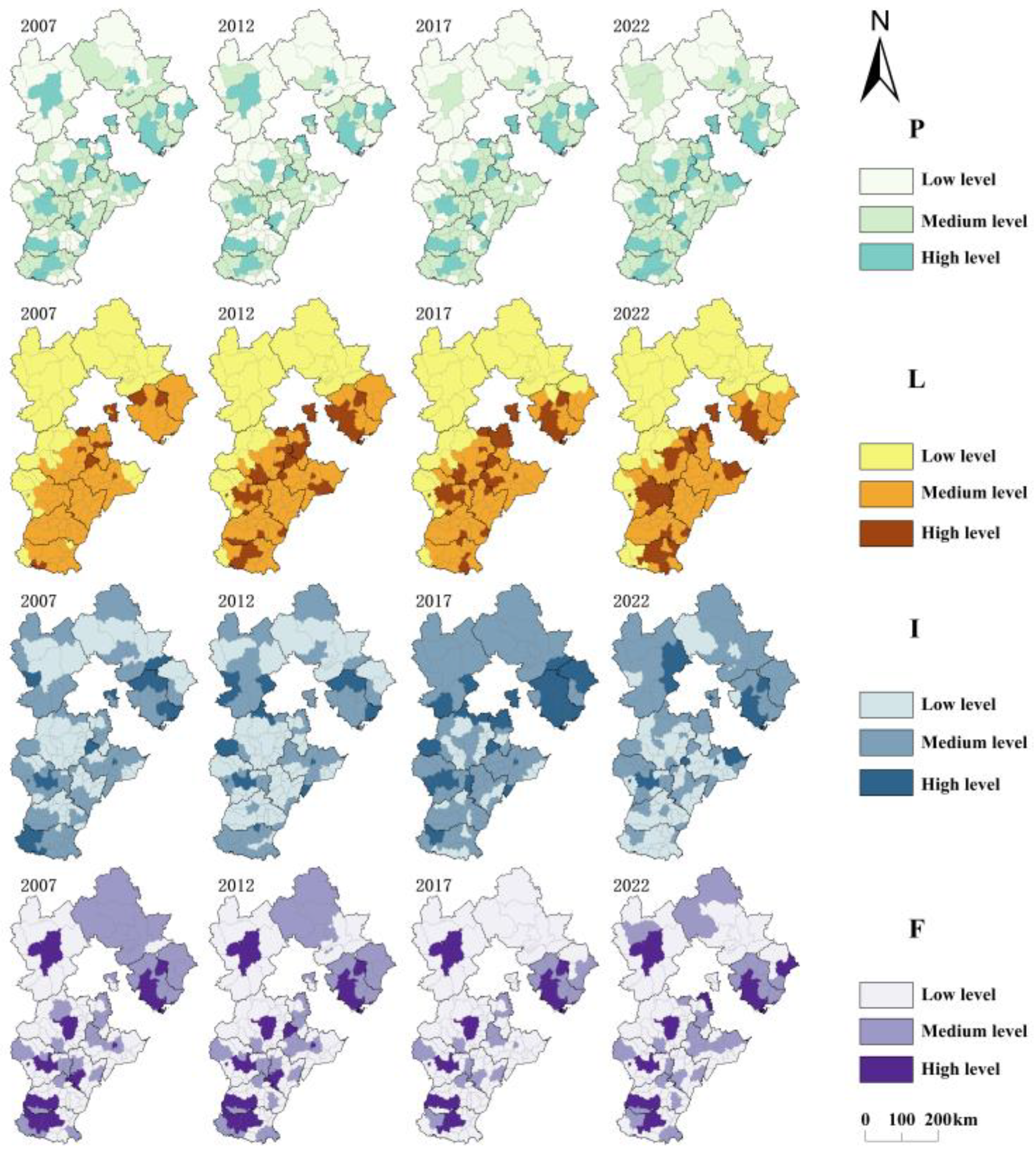
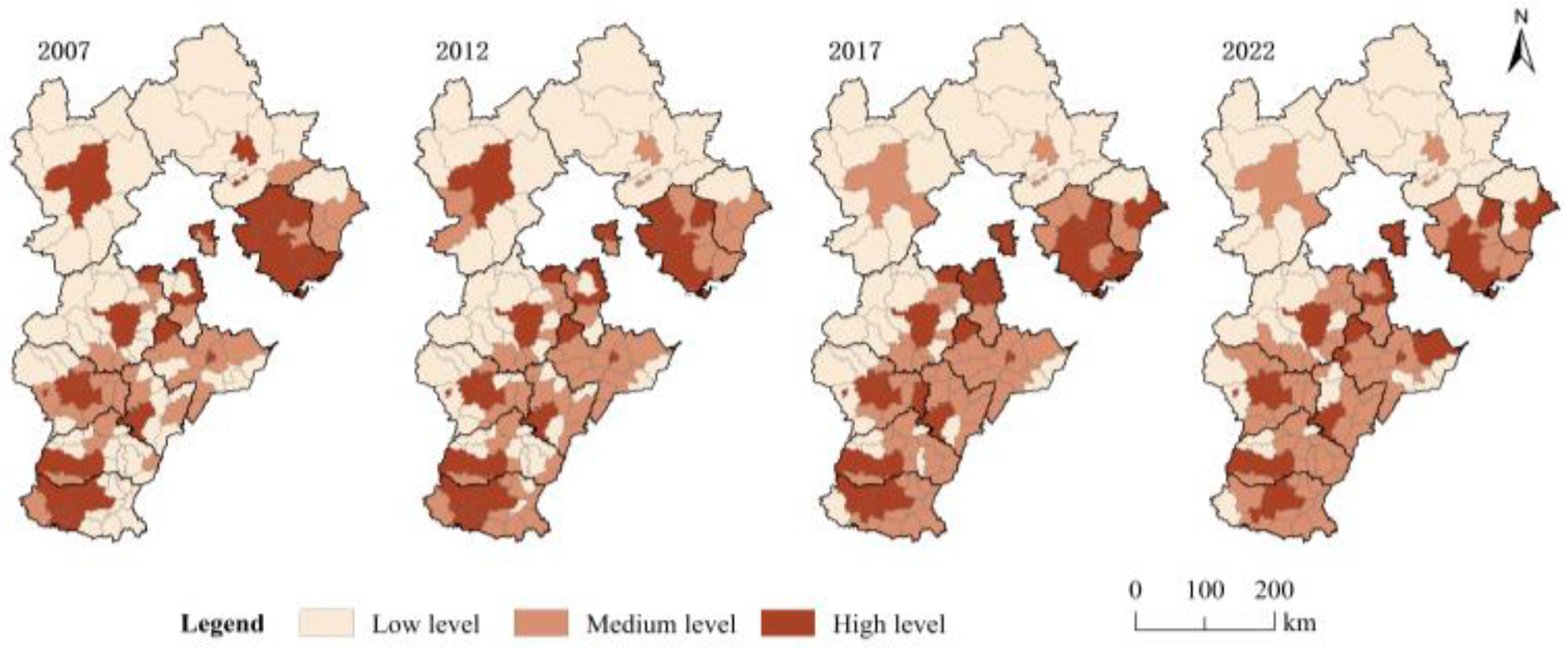
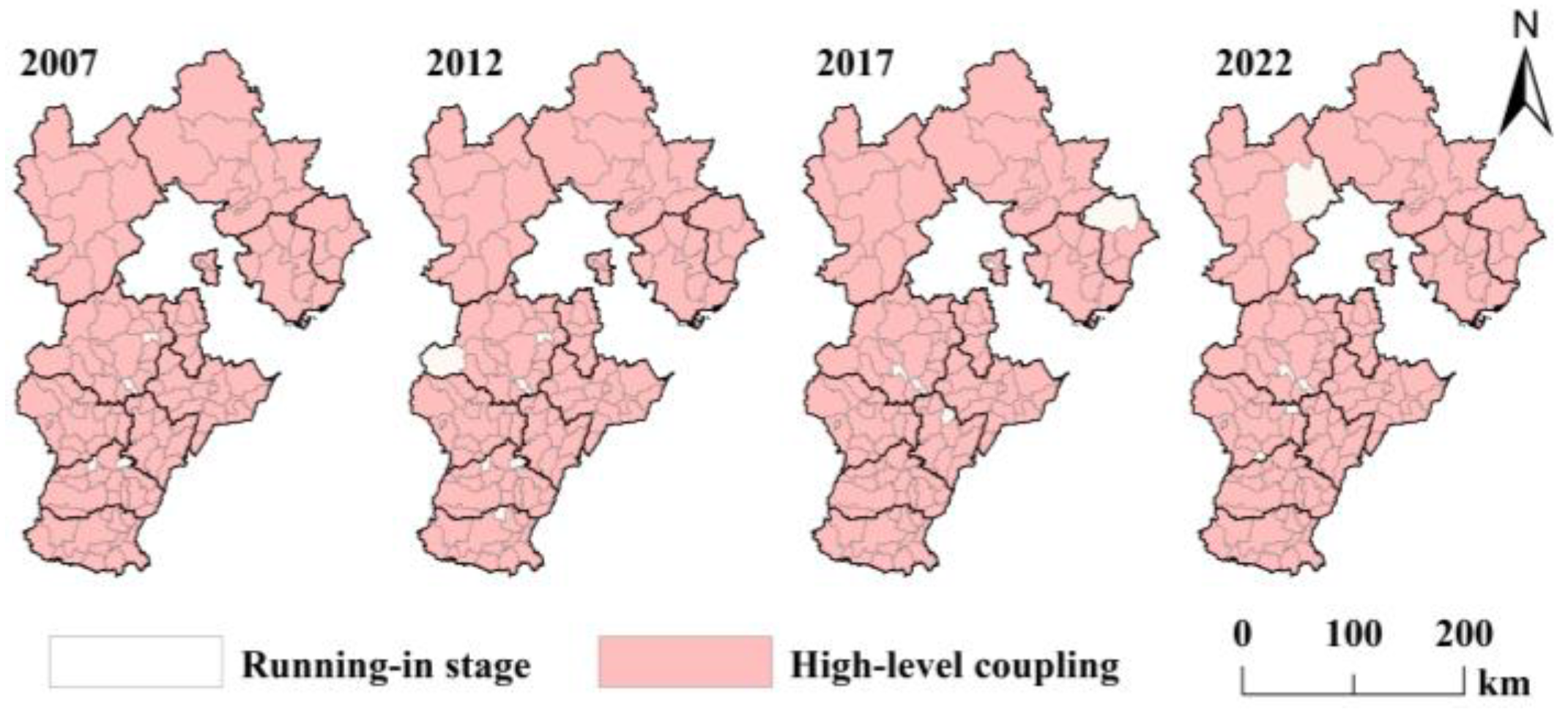

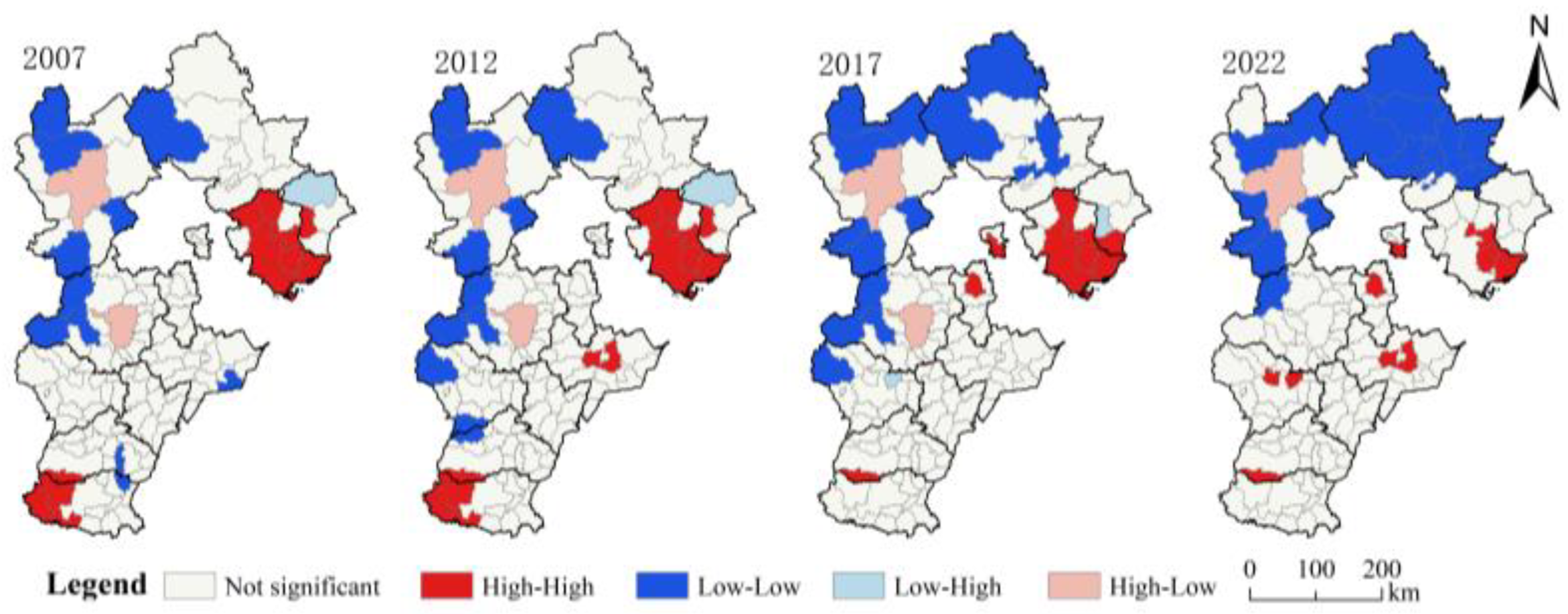
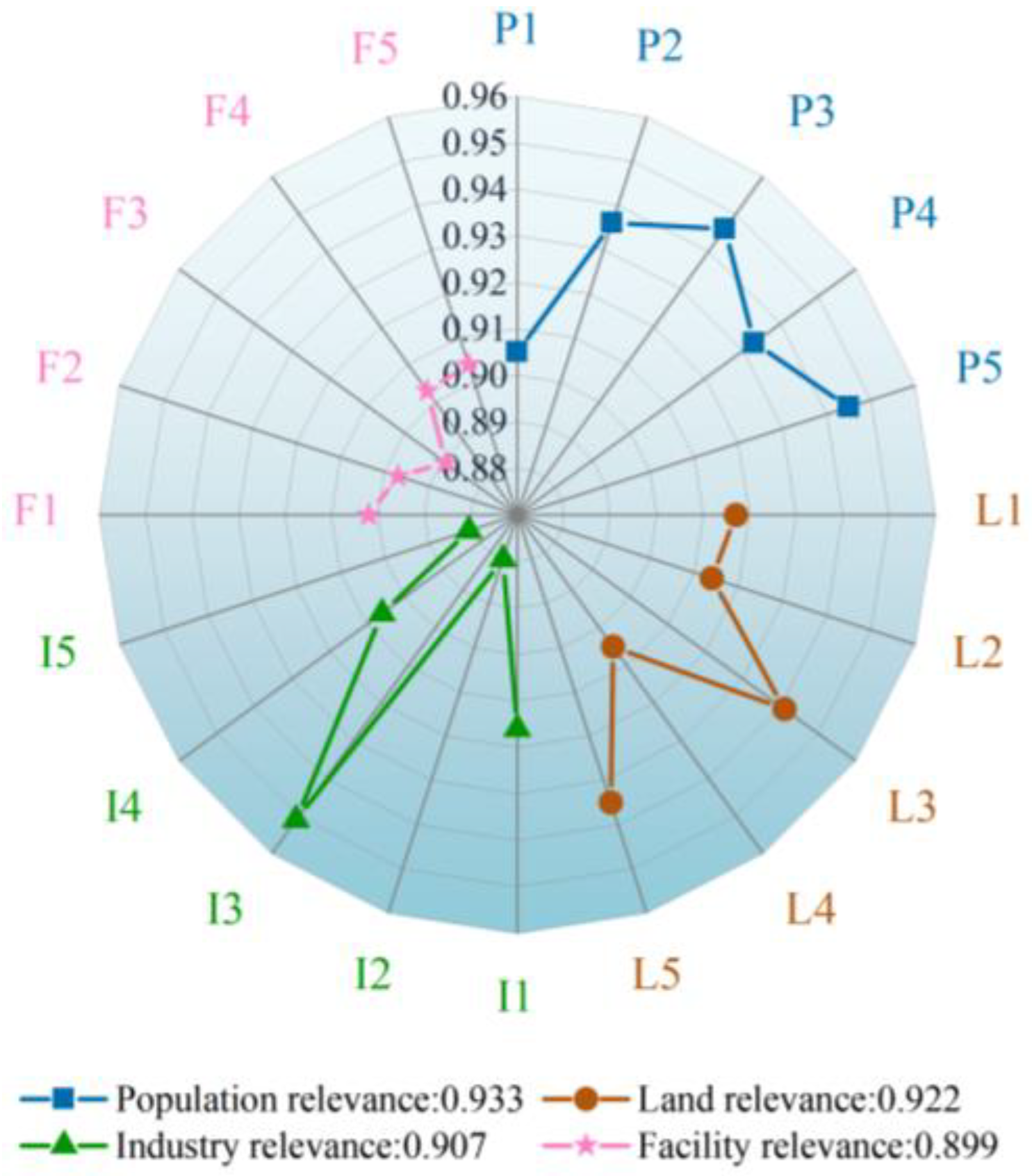
| Target Layer | Index Layer | Number | Unit | Weight |
|---|---|---|---|---|
| Population | Density of population | P1 | persons/km2 | 0.238 |
| Population urbanization rate | P2 | 0.215 | ||
| Rural labor force non-agriculturalization | P3 | % | 0.127 | |
| Number of medical and health technicians per 10,000 people | P4 | persons | 0.301 | |
| Number of regular secondary school teachers per 10,000 people | P5 | persons | 0.12 | |
| Land | Proportion of cultivated land area | L1 | % | 0.151 |
| Proportion of construction land area | L2 | % | 0.22 | |
| Average public financial revenue per land area | L3 | ten thousand yuan/km2 | 0.15 | |
| Average public financial expenditure per land area | L4 | ten thousand yuan/km2 | 0.357 | |
| Average social investment in fixed assets | L5 | ten thousand yuan/km2 | 0.123 | |
| Industry | Per capita regional GDP | I1 | ten thousand yuan/person | 0.238 |
| Share of the primary industry | I2 | % | 0.132 | |
| Share of the tertiary industry | I3 | % | 0.124 | |
| Industrial sophistication level | I4 | % | 0.213 | |
| Per capita industrial output value | I5 | ten thousand yuan/person | 0.293 | |
| Facility | Highway mileage | F1 | km | 0.119 |
| Effective irrigation area | F2 | hm2 | 0.147 | |
| Per capita electricity consumption in the whole society | F3 | kWh/person | 0.258 | |
| Number of hospitals and health centers | F4 | unit | 0.249 | |
| Number of ordinary high schools | F5 | unit | 0.227 |
| Range of Coupling | Type of Coupling | Characteristics of Coupling |
|---|---|---|
| 0 < C ≤ 0.3 | Low-level coupling | The correlation among each subsystem is relatively weak. |
| 0.3 < C ≤ 0.5 | Antagonistic stage | The correlation among each subsystem is constantly improving and shows a trend from weak to strong. |
| 0.5 < C ≤ 0.8 | Running-in stage | The degree of correlation among each subsystem is continuously increasing, and the system is developing in an orderly manner. |
| 0.8 < C ≤ 1 | High-level coupling | Each subsystem is tending towards a period of benign resonance coupling. |
| Coupling Coordination Degree | Coupling Coordinate Type | Coupling Coordination Stage |
|---|---|---|
| 0 < D ≤ 0.2 | Serious imbalance | Imbalance development stage |
| 0.2 < D ≤ 0.35 | Mild imbalance | |
| 0.35 < D ≤ 0.4 | On the brink of imbalance | Transition stage |
| 0.4 < D ≤ 0.5 | Barely coordination | |
| 0.5 < D ≤ 0.6 | Primary coordination | Coordinated development stage |
| 0.6 < D ≤ 0.8 | Moderate coordination | |
| 0.8 < D < 1 | Excellent coordination |
| Global Moran’s I | Year | |||
|---|---|---|---|---|
| 2007 | 2012 | 2017 | 2022 | |
| I | 0.291 | 0.258 | 0.292 | 0.27 |
| p-value | 0.001 | 0.001 | 0.001 | 0.001 |
| Z-value | 5.0677 | 4.4738 | 4.9074 | 4.4547 |
Disclaimer/Publisher’s Note: The statements, opinions and data contained in all publications are solely those of the individual author(s) and contributor(s) and not of MDPI and/or the editor(s). MDPI and/or the editor(s) disclaim responsibility for any injury to people or property resulting from any ideas, methods, instructions or products referred to in the content. |
© 2025 by the authors. Licensee MDPI, Basel, Switzerland. This article is an open access article distributed under the terms and conditions of the Creative Commons Attribution (CC BY) license (https://creativecommons.org/licenses/by/4.0/).
Share and Cite
Niu, Y.; Zhao, L.; Xie, J.; Zhou, H.; Zang, J.; Zhao, C. Population–Land–Industry–Facility System Coupling Coordination and Influencing Factors in Hebei Province. Land 2025, 14, 2043. https://doi.org/10.3390/land14102043
Niu Y, Zhao L, Xie J, Zhou H, Zang J, Zhao C. Population–Land–Industry–Facility System Coupling Coordination and Influencing Factors in Hebei Province. Land. 2025; 14(10):2043. https://doi.org/10.3390/land14102043
Chicago/Turabian StyleNiu, Yichun, Li Zhao, Jiaxi Xie, Haoyu Zhou, Junjie Zang, and Chunxiu Zhao. 2025. "Population–Land–Industry–Facility System Coupling Coordination and Influencing Factors in Hebei Province" Land 14, no. 10: 2043. https://doi.org/10.3390/land14102043
APA StyleNiu, Y., Zhao, L., Xie, J., Zhou, H., Zang, J., & Zhao, C. (2025). Population–Land–Industry–Facility System Coupling Coordination and Influencing Factors in Hebei Province. Land, 14(10), 2043. https://doi.org/10.3390/land14102043





